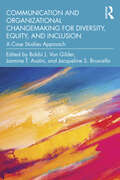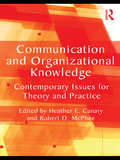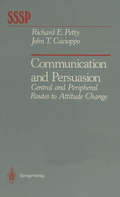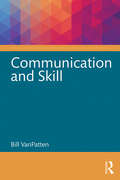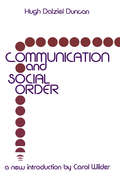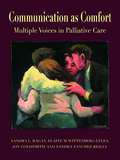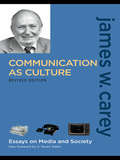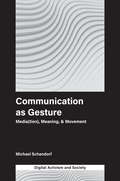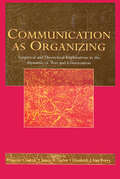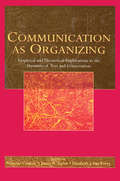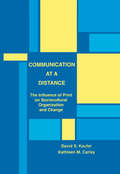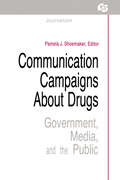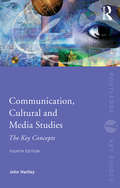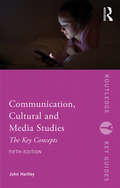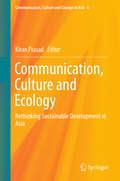- Table View
- List View
Communication and Organizational Changemaking for Diversity, Equity, and Inclusion: A Case Studies Approach
This book explores the opportunities, challenges, and effective approaches to organizational change regarding diversity, equity, inclusion, and belonging. Featuring application-based case studies and practical guidelines for meaningful organizational change, this book problematizes some of the current DEI initiatives in today’s organizations. It examines multiple forms of diversity (e.g., race, age, and mental health) from a variety of perspectives (e.g., leadership and employee), with case studies that demonstrate how changemaking efforts can be reimagined and implemented in better, more nuanced, and more sustainable ways to produce meaningful organizational change. Through these case studies, readers learn from organizations’ successes and failures in their attempts to implement DEI practices. Each chapter concludes with explicit practical implications and/or actionable recommendations for organizational changemaking. This text will make an impactful addition to courses in communication and diversity or organizational communication/change at the advanced undergraduate or graduate level, and will be an essential guide for professionals wishing to lead change in their organizations.
Communication and Organizational Knowledge: Contemporary Issues for Theory and Practice (Routledge Communication Series)
by Heather E. CanaryThis book provides an overview of communication-centered theory and research regarding organizational knowledge and learning. It brings the work of scholars in communication, management, information technology, and other disciplines together in a coherent volume that represents existing research and theory on communication-related knowledge work. Chapters address what constitutes knowledge, how knowledge functions within and across organizations, and how organizational members develop and manage knowledge for organizational purposes. The book also provides a forum for these scholars to pose directions for future research and theorizing. It will serve as a reference tool for scholars and practitioners to identify and understand communicative features of organizational knowledge processes.
Communication and Organizational Knowledge: Contemporary Issues for Theory and Practice (Routledge Communication Series)
by Heather E. Canary Robert D. McPheeThis book provides an overview of communication-centered theory and research regarding organizational knowledge and learning. It brings the work of scholars in communication, management, information technology, and other disciplines together in a coherent volume that represents existing research and theory on communication-related knowledge work. Chapters address what constitutes knowledge, how knowledge functions within and across organizations, and how organizational members develop and manage knowledge for organizational purposes. The book also provides a forum for these scholars to pose directions for future research and theorizing. It will serve as a reference tool for scholars and practitioners to identify and understand communicative features of organizational knowledge processes.
Communication and Persuasion: Central and Peripheral Routes to Attitude Change (Springer Series in Social Psychology)
by Richard E. Petty John T. CacioppoIt has been over 10 years since we initiated work on our first series of collaborative experiments. As graduate students, we had great fun planning, conducting, and writing this research (Petty & Cacioppo, 1977). We enjoyed arguing with each other at our initial meeting in 1973 and have sub sequently become best friends, but neither of us suspected at the time that we would or could actively maintain a research collaboration over the next decade, or that we would now find ourselves in a position to write this monograph. As we note in Chapter 1, we began our studies of persuasion at a time when social psychology was in "crisis," and interest in research on attitude change in particular was declining. As we write this, we are aware of six new volumes on persuasion that are in press or in preparation and that should appear over the next few years. In retrospect, it is not so surprising that research on attitudes and persuasion would reemerge as a central concern of social psychology. We believe that human feelings, beliefs, and behaviors, whether in the domain of interpersonal relations (e. g. , marriage, aggression), politics (e. g. , voting, revolution), health (e. g. , following a medical regimen), or economics (e. g. , consumer purchases) are greatly influenced by the evaluations people have of other people, objects, and issues. Furthermore, evaluations (attitudes) are influenced by affect, cognition, and behavior.
Communication and Skill (The Routledge E-Modules on Contemporary Language Teaching)
by Bill VanPattenIn this module on communication, the reader explores the nature and consequences of a particular definition of communication: the expression and interpretation of meaning in a given context. Special attention is given to context (i.e., physical setting, participants, purpose of communication) and how these impact how we think about communication in language classrooms. Please visit the series companion website for more information: http://routledgetextbooks.com/textbooks/9781315679594/
Communication and Skill (The Routledge E-Modules on Contemporary Language Teaching)
by Bill VanPattenIn this module on communication, the reader explores the nature and consequences of a particular definition of communication: the expression and interpretation of meaning in a given context. Special attention is given to context (i.e., physical setting, participants, purpose of communication) and how these impact how we think about communication in language classrooms. Please visit the series companion website for more information: http://routledgetextbooks.com/textbooks/9781315679594/
Communication and Social Order
by Hugh Dalziel DuncanIn this highly influential study of art forms as models for a theory of communications, Hugh Dalziel Duncan demonstrates that without understanding of the role of symbols in society, social scientists cannot hope to develop adequate models for social analysis. He reviews critically major contributions to communication theory during the past century: Freud's analysis of dream symbolism, Simmel's concept of sociability, James' insights into religious experience, and Dewey's relating of art to experience.
Communication and Social Order
by Hugh Dalziel DuncanIn this highly influential study of art forms as models for a theory of communications, Hugh Dalziel Duncan demonstrates that without understanding of the role of symbols in society, social scientists cannot hope to develop adequate models for social analysis. He reviews critically major contributions to communication theory during the past century: Freud's analysis of dream symbolism, Simmel's concept of sociability, James' insights into religious experience, and Dewey's relating of art to experience.
Communication as Comfort: Multiple Voices in Palliative Care (Routledge Communication Series)
by Sandra L. Ragan Elaine M. Wittenberg-Lyles Joy Goldsmith Sandra Sanchez ReillyThis exceptional work explores the complexities of communication at one of the most critical stages of the life experience--during advanced, serious illness and at the end of life. Challenging the predominantly biomedical model that informs much communication between seriously ill and/or dying patients and their physicians, caregivers, and families, Sandra L. Ragan, Elaine M. Wittenberg-Lyles, Joy Goldsmith, and Sandra Sanchez-Reilly pose palliative care--medical care designed to comfort rather than to cure patients--as an antidote to the experience of most Americans at the most vulnerable juncture of their lives. With an author team comprised of three health communication scholars and one physician certified in geriatrics and palliative medicine, this volume integrates the medical literature on palliative care with that of health communication researchers who advocate a biopsychosocial approach to health care. Applying communication theories and insights to illuminate problems and to explain their complexities, the authors advocate a patient-centered approach to care that recognizes and seeks to lessen patients’ suffering and the many types of pain they may experience (physical, psychological, social, and spiritual) during life-threatening illness.
Communication as Comfort: Multiple Voices in Palliative Care (Routledge Communication Series)
by Sandra L. Ragan Elaine M. Wittenberg-Lyles Joy Goldsmith Sandra Sanchez ReillyThis exceptional work explores the complexities of communication at one of the most critical stages of the life experience--during advanced, serious illness and at the end of life. Challenging the predominantly biomedical model that informs much communication between seriously ill and/or dying patients and their physicians, caregivers, and families, Sandra L. Ragan, Elaine M. Wittenberg-Lyles, Joy Goldsmith, and Sandra Sanchez-Reilly pose palliative care--medical care designed to comfort rather than to cure patients--as an antidote to the experience of most Americans at the most vulnerable juncture of their lives. With an author team comprised of three health communication scholars and one physician certified in geriatrics and palliative medicine, this volume integrates the medical literature on palliative care with that of health communication researchers who advocate a biopsychosocial approach to health care. Applying communication theories and insights to illuminate problems and to explain their complexities, the authors advocate a patient-centered approach to care that recognizes and seeks to lessen patients’ suffering and the many types of pain they may experience (physical, psychological, social, and spiritual) during life-threatening illness.
Communication as Culture, Revised Edition: Essays on Media and Society
by James W. CareyIn this classic text, James W. Carey maintains that communication is not merely the transmission of information; reminding the reader of the link between the words "communication" and "community," he broadens his definition to include the drawing-together of a people that is culture. In this context, Carey questions the American tradition of focusing only on mass communication's function as a means of social and political control, and makes a case for examining the content of a communication—the meaning of symbols, not only the motives that originate them or the purposes they serve. He seeks to recast the goal of communication studies, replacing the search for deterministic laws of behavior with a simpler, yet far more challenging mission: "to enlarge the human conversation by comprehending what others are saying." This new edition includes a new critical foreword by G. Stuart Adam that explains Carey's fundamental role in transforming the study of mass communication to include a cultural perspective and connects his classic essays with contemporary media issues and trends. This edition also adds a new, complete bibliography of all of Carey's writings.
Communication as Culture, Revised Edition: Essays on Media and Society
by James W. CareyIn this classic text, James W. Carey maintains that communication is not merely the transmission of information; reminding the reader of the link between the words "communication" and "community," he broadens his definition to include the drawing-together of a people that is culture. In this context, Carey questions the American tradition of focusing only on mass communication's function as a means of social and political control, and makes a case for examining the content of a communication—the meaning of symbols, not only the motives that originate them or the purposes they serve. He seeks to recast the goal of communication studies, replacing the search for deterministic laws of behavior with a simpler, yet far more challenging mission: "to enlarge the human conversation by comprehending what others are saying." This new edition includes a new critical foreword by G. Stuart Adam that explains Carey's fundamental role in transforming the study of mass communication to include a cultural perspective and connects his classic essays with contemporary media issues and trends. This edition also adds a new, complete bibliography of all of Carey's writings.
Communication as Gesture: Media(tion), Meaning, & Movement (Digital Activism and Society: Politics, Economy and Culture in Network Communication)
by Michael SchandorfWhile the concept of communication has long been bound to a reductive model of the exchange of information, very few scholars of communication would argue that these assumptions are realistic, without a long list of qualifying caveats. But the concept of communication, built from the integration of semiotic signification with the idea of information as the 'carrier' of transmitted meaning, is so deeply ingrained and simple that even displacing it can seem futile, if not absurd. Nevertheless, these foundational assumptions tightly constrain the ways in which any interactional phenomena can be conceived--and constraints upon our ways of understanding communication drastically limit our capacity to understand our worlds and the social processes that generate them, at any scale or level of abstraction. Communication as Gesture traces the concept of communication from its roots in classical rhetoric to its integration in structural linguistics, semiotics, information theory, and cybernetics, integrating perspectives from contemporary rhetorical theory, relational psychology, interactional sociology, philosophy, cognitive linguistics, discourse studies, multimodal semiotics, and more. Because so much of our contemporary world is lived with and through digital media technologies, the study of new media and social media provides a rich illustration of the constraints imposed by our reductive assumptions--and hints at the possibilities generated by rethinking them. The gesture theory of communication introduced presents a dimensional account of communication that is intuitively accessible and theoretically rich while overturning reductive assumptions of the linear character of interaction.
Communication as Gesture: Media(tion), Meaning, & Movement (Digital Activism and Society: Politics, Economy and Culture in Network Communication)
by Michael SchandorfWhile the concept of communication has long been bound to a reductive model of the exchange of information, very few scholars of communication would argue that these assumptions are realistic, without a long list of qualifying caveats. But the concept of communication, built from the integration of semiotic signification with the idea of information as the 'carrier' of transmitted meaning, is so deeply ingrained and simple that even displacing it can seem futile, if not absurd. Nevertheless, these foundational assumptions tightly constrain the ways in which any interactional phenomena can be conceived--and constraints upon our ways of understanding communication drastically limit our capacity to understand our worlds and the social processes that generate them, at any scale or level of abstraction. Communication as Gesture traces the concept of communication from its roots in classical rhetoric to its integration in structural linguistics, semiotics, information theory, and cybernetics, integrating perspectives from contemporary rhetorical theory, relational psychology, interactional sociology, philosophy, cognitive linguistics, discourse studies, multimodal semiotics, and more. Because so much of our contemporary world is lived with and through digital media technologies, the study of new media and social media provides a rich illustration of the constraints imposed by our reductive assumptions--and hints at the possibilities generated by rethinking them. The gesture theory of communication introduced presents a dimensional account of communication that is intuitively accessible and theoretically rich while overturning reductive assumptions of the linear character of interaction.
Communication as Organizing: Empirical and Theoretical Explorations in the Dynamic of Text and Conversation (Routledge Communication Series)
by François Cooren James R. Taylor Elizabeth J. Van EveryCommunication as Organizing unites multiple reflections on the role of language under a single rubric: the organizing role of communication. Stemming from Jim Taylor's earlier work, The Emergent Organization: Communication as Its Site and Surface (LEA, 2000), the volume editors present a communicational answer to the question, "what is an organization?" through contributions from an international set of scholars and researchers. The chapter authors synthesize various lines of research on constituting organizations through communication, describing their explorations of the relation between language, human practice, and the constitution of organizational forms. Each chapter develops a dimension of the central theme, showing how such concepts as agency, identity, sensemaking, narrative and account may be put to work in discursive analysis to develop effective research into organizing processes. The contributions employ concrete examples to show how the theoretical concepts can be employed to develop effective research. This distinctive volume encourages readers to discover and develop a truly communicational means of addressing the question of organization, addressing how organization itself emerges in the course of communicational transactions. In presenting a single and entirely communicational perspective for exploring organizational phenomena, grounded in the discourse of communicational transactions and the establishment of relationships through language, it is required reading for scholars, researchers, and graduate students working in organizational communication, management, social psychology, pragmatics of language, and organizational studies.
Communication as Organizing: Empirical and Theoretical Explorations in the Dynamic of Text and Conversation (Routledge Communication Series)
by Francois Cooren James R. Taylor Elizabeth J. Van EveryCommunication as Organizing unites multiple reflections on the role of language under a single rubric: the organizing role of communication. Stemming from Jim Taylor's earlier work, The Emergent Organization: Communication as Its Site and Surface (LEA, 2000), the volume editors present a communicational answer to the question, "what is an organization?" through contributions from an international set of scholars and researchers. The chapter authors synthesize various lines of research on constituting organizations through communication, describing their explorations of the relation between language, human practice, and the constitution of organizational forms. Each chapter develops a dimension of the central theme, showing how such concepts as agency, identity, sensemaking, narrative and account may be put to work in discursive analysis to develop effective research into organizing processes. The contributions employ concrete examples to show how the theoretical concepts can be employed to develop effective research. This distinctive volume encourages readers to discover and develop a truly communicational means of addressing the question of organization, addressing how organization itself emerges in the course of communicational transactions. In presenting a single and entirely communicational perspective for exploring organizational phenomena, grounded in the discourse of communicational transactions and the establishment of relationships through language, it is required reading for scholars, researchers, and graduate students working in organizational communication, management, social psychology, pragmatics of language, and organizational studies.
Communication at A Distance: The Influence of Print on Sociocultural Organization and Change (Routledge Communication Series)
by David S. Kaufer Kathleen M. CarleyThis book bridges an important gap between two major approaches to mass communication -- historical and social scientific. To do so, it employs a theory of communication that unifies social, cultural and technological concerns into a systematic and formal framework that is then used to examine the impact of print within the larger socio-cultural context and across multiple historical contexts. The authors integrate historical studies and more abstract formal representations, achieving a set of logically coherent and well-delimited hypotheses that invite further exploration, both historically and experimentally. A second gap that the book addresses is in the area of formal models of communication and diffusion. Such models typically assume a homogeneous population and a communication whose message is abstracted from the complexities of language processing. In contrast, the model presented in this book treats the population as heterogeneous and communications as potentially variable in their content as they move across speakers or readers. Written to address and overcome many of the disciplinary divisions that have prevented the study of print from being approached from the perspective of a unified theory, this book employs a focused interdisciplinary position that encompasses several domains. It shows the underlying compatibility between cognitive and social theory; between the study of language and cognition and the study of technology; between the postmodern interest in the instability of meaning and the social science interest in the diffusion of information; between the effects of technology and issues of cultural homogeneity and heterogeneity. Overall, this book reveals how small, relatively non-interactive, disciplinary-specific conversations about print are usefully conceived of as part of a larger interdisciplinary inquiry.
Communication at A Distance: The Influence of Print on Sociocultural Organization and Change (Routledge Communication Series)
by David S. Kaufer Kathleen M. CarleyThis book bridges an important gap between two major approaches to mass communication -- historical and social scientific. To do so, it employs a theory of communication that unifies social, cultural and technological concerns into a systematic and formal framework that is then used to examine the impact of print within the larger socio-cultural context and across multiple historical contexts. The authors integrate historical studies and more abstract formal representations, achieving a set of logically coherent and well-delimited hypotheses that invite further exploration, both historically and experimentally. A second gap that the book addresses is in the area of formal models of communication and diffusion. Such models typically assume a homogeneous population and a communication whose message is abstracted from the complexities of language processing. In contrast, the model presented in this book treats the population as heterogeneous and communications as potentially variable in their content as they move across speakers or readers. Written to address and overcome many of the disciplinary divisions that have prevented the study of print from being approached from the perspective of a unified theory, this book employs a focused interdisciplinary position that encompasses several domains. It shows the underlying compatibility between cognitive and social theory; between the study of language and cognition and the study of technology; between the postmodern interest in the instability of meaning and the social science interest in the diffusion of information; between the effects of technology and issues of cultural homogeneity and heterogeneity. Overall, this book reveals how small, relatively non-interactive, disciplinary-specific conversations about print are usefully conceived of as part of a larger interdisciplinary inquiry.
Communication Campaigns About Drugs: Government, Media, and the Public (Routledge Communication Series)
by Pamela J. ShoemakerPublished in 1989, Communication Campaigns About Drugs is a valuable contribution to the field of Communication Studies.
Communication Campaigns About Drugs: Government, Media, and the Public (Routledge Communication Series)
by Pamela J. ShoemakerPublished in 1989, Communication Campaigns About Drugs is a valuable contribution to the field of Communication Studies.
Communication, Cultural and Media Studies: The Key Concepts (Routledge Key Guides)
by John HartleyThis fourth edition of Communication, Cultural and Media Studies: The Key Concepts is an indispensible guide to the most important terms in the field. It offers clear explanations of the key concepts, exploring their origins, what they’re used for and why they provoke discussion. The author provides a multi-disciplinary explanation and assessment of the key concepts, from ‘authorship’ to ‘censorship’; ‘creative industries’ to ‘network theory’; ‘complexity’ to ‘visual culture’. The new edition of this classic text includes: Over 200 entries including 50 new entries All entries revised, rewritten and updated Coverage of recent developments in the field Insight into interactive media and the knowledge-based economy A fully updated bibliography with 400 items and suggestions for further reading throughout the text
Communication, Cultural and Media Studies: The Key Concepts (Routledge Key Guides)
by John HartleyThis fourth edition of Communication, Cultural and Media Studies: The Key Concepts is an indispensible guide to the most important terms in the field. It offers clear explanations of the key concepts, exploring their origins, what they’re used for and why they provoke discussion. The author provides a multi-disciplinary explanation and assessment of the key concepts, from ‘authorship’ to ‘censorship’; ‘creative industries’ to ‘network theory’; ‘complexity’ to ‘visual culture’. The new edition of this classic text includes: Over 200 entries including 50 new entries All entries revised, rewritten and updated Coverage of recent developments in the field Insight into interactive media and the knowledge-based economy A fully updated bibliography with 400 items and suggestions for further reading throughout the text
Communication, Cultural and Media Studies: The Key Concepts (Routledge Key Guides)
by John HartleyNow in its fifth edition, this pioneering volume of Routledge’s ‘Key Concepts’ series offers clear explanations of key concepts, showing where they came from, what they are used for, and why they provoke discussion or disagreement. The new edition is extensively revised to keep pace with rapidly evolving developments in communication, culture and media, providing topical and authoritative guidance to transformational shifts from broadcast to digital technologies, national to global media and disciplinary to diverse knowledge. It includes: Nearly 250 entries, covering what and how to study across this multi-disciplinary field 50 new entries: from algorithm and assemblage, dance and data, to woke and worldbuilding Updated references with 500 items and suggestions for further reading Revisions, updates and examples throughout. For students and seasoned scholars alike, Communication, Cultural and Media Studies is an invaluable resource in an ever-changing landscape.
Communication, Cultural and Media Studies: The Key Concepts (Routledge Key Guides)
by John HartleyNow in its fifth edition, this pioneering volume of Routledge’s ‘Key Concepts’ series offers clear explanations of key concepts, showing where they came from, what they are used for, and why they provoke discussion or disagreement. The new edition is extensively revised to keep pace with rapidly evolving developments in communication, culture and media, providing topical and authoritative guidance to transformational shifts from broadcast to digital technologies, national to global media and disciplinary to diverse knowledge. It includes: Nearly 250 entries, covering what and how to study across this multi-disciplinary field 50 new entries: from algorithm and assemblage, dance and data, to woke and worldbuilding Updated references with 500 items and suggestions for further reading Revisions, updates and examples throughout. For students and seasoned scholars alike, Communication, Cultural and Media Studies is an invaluable resource in an ever-changing landscape.
Communication, Culture and Ecology: Rethinking Sustainable Development in Asia (Communication, Culture and Change in Asia #6)
by Kiran PrasadThis book offers comprehensive insights into the cultural and ecological values that influence sustainable development across Asia, addressing the cultural, religious and philosophical moorings of development through participatory and grassroots communication approaches. It presents a range of contributions and case studies from leading experts in Asia to highlight the debates on environmental communication and sustainable development that are relevant today, and to provide an overview of the positive traditions of ecological sensitivity and cultural communication that may find common ground between communities. This well-researched guide to the dynamic and complex terrain of communication for sustainable development offers uniquely practical perspectives on communication, environment and sustainable development that are of immense value for policy makers, media scholars, development practitioners, researchers and students of communication and media studies.
